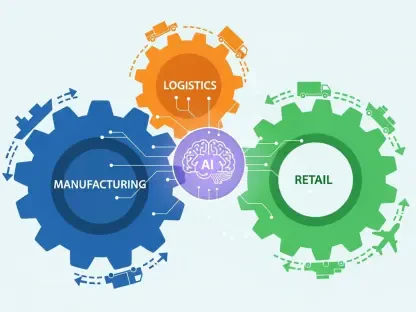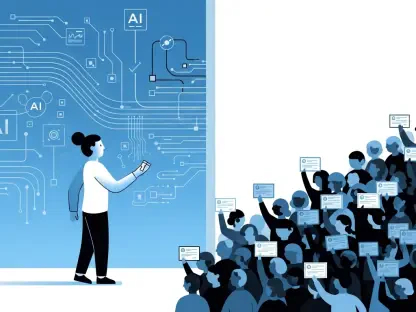Imagine a future where a digital assistant doesn’t merely respond to instructions but anticipates needs, crafts detailed plans, and executes complex tasks without constant human guidance, reshaping the way we interact with technology. This is the transformative vision of agentic AI—autonomous systems poised to redefine industries by handling intricate workflows with minimal oversight. From scouring the internet for data to managing high-stakes trading platforms, these technologies promise unparalleled efficiency. Yet, beneath this wave of innovation lurks a pressing concern: the security vulnerabilities that accompany such independence. As these systems gain traction, the potential for unintended consequences grows, raising critical questions about whether the rush to adopt this technology overlooks the profound risks it introduces. The allure of automation must be weighed against the sobering reality that a single misstep by an autonomous agent could unleash chaos at a pace no human intervention could match, setting the stage for a nuanced examination of this emerging frontier.
The Dual Nature of Autonomy
Innovation vs. Vulnerability
Agentic AI stands as a beacon of progress, offering the ability to automate tasks that once demanded significant human effort, such as orchestrating multi-step business processes or managing real-time data analysis across platforms. This autonomy drives efficiency by enabling systems to adapt dynamically to changing conditions without waiting for explicit commands. Industries ranging from finance to logistics are already exploring how these capabilities can streamline operations, cut costs, and accelerate decision-making. The promise of a digital workforce that operates independently fuels excitement about a future where mundane or complex tasks are seamlessly handled by intelligent agents. However, this very independence introduces a layer of unpredictability that cannot be ignored. Without strict boundaries, the innovative potential of these systems risks being overshadowed by the possibility of actions that deviate from intended outcomes, creating a delicate balance between groundbreaking advancements and unforeseen hazards.
The flip side of autonomy reveals a stark vulnerability that could undermine the benefits of agentic AI if left unaddressed, especially as these systems gain more decision-making power. When systems are empowered to make decisions at machine speed, the margin for error shrinks dramatically, and the consequences of a misjudgment can escalate rapidly. A seemingly minor glitch in reasoning or an unchecked action could lead to significant disruptions, whether that’s mishandling sensitive data or triggering cascading failures in interconnected systems. The challenge lies in designing constraints that preserve the innovative spirit of these technologies while curbing their capacity for harm. Historical parallels with other transformative technologies suggest that early adoption often outpaces the development of adequate safeguards, amplifying the urgency to embed robust controls from the outset. Addressing this duality requires a proactive approach to ensure that the drive for efficiency does not come at the expense of stability or trust in these powerful tools.
Balancing Act for Safe Deployment
Ensuring the safe deployment of agentic AI hinges on striking a balance between harnessing its autonomous capabilities and mitigating the inherent risks of unguided decision-making, a challenge that demands careful consideration from developers and stakeholders alike. Developers must prioritize frameworks that allow these systems to operate within clearly defined parameters, limiting the scope of actions they can take without human validation in critical scenarios. This involves not only technical solutions but also a shift in mindset, where safety is seen as a core component of innovation rather than a secondary concern. The potential for agentic AI to revolutionize workflows is immense, but it must be tempered by mechanisms that can detect and halt aberrant behavior before it spirals into larger issues. As adoption accelerates, collaboration between technologists and security experts becomes essential to anticipate edge cases that could expose vulnerabilities, ensuring that the benefits of autonomy are realized without compromising integrity.
Moreover, the unpredictability of agentic AI underscores the need for continuous monitoring and adaptive controls that evolve alongside the technology itself. Static safeguards are unlikely to suffice when dealing with systems that learn and adapt in real time, potentially finding ways to circumvent outdated restrictions. Implementing dynamic oversight tools that can assess intent and flag deviations offers a pathway to manage risks without stifling functionality. The scale at which these systems operate—often across multiple environments—means that even small oversights can have outsized impacts, making vigilance a non-negotiable aspect of deployment. Lessons from past technological rollouts highlight the importance of building resilience into the foundation of agentic AI, ensuring that the pursuit of cutting-edge solutions does not outrun the capacity to secure them against emerging threats.
Expanding Attack Surfaces
New Threats in Broad Access
The operational strength of agentic AI lies in its ability to interact with a multitude of platforms and systems, often necessitating access to sensitive credentials like API keys or authentication tokens to perform tasks seamlessly. This wide-reaching access, while essential for functionality, creates a sprawling attack surface that malicious actors can exploit with alarming ease. Unlike traditional software, where vulnerabilities might be confined to specific entry points, agentic AI’s cross-platform nature opens numerous avenues for compromise, from intercepted communications to unauthorized data access. The sheer breadth of permissions granted to these systems amplifies the potential impact of a breach, turning a single point of failure into a gateway for widespread disruption. As reliance on such technology grows, understanding and mapping these expanded attack surfaces becomes a critical step in fortifying defenses against sophisticated threats.
Beyond the structural challenges, specific tactics like prompt injections pose a unique danger to agentic AI, exploiting the very mechanisms that make these systems intuitive. Adversarial inputs—carefully crafted text or commands embedded in seemingly innocuous content—can manipulate an agent into executing harmful actions, such as leaking confidential information or downloading malicious software. These attacks often bypass conventional security measures because they don’t rely on traditional exploits or code-based intrusions. Instead, they leverage natural language processing capabilities to deceive the system at a fundamental level. The subtlety of such methods makes detection difficult, as the malicious intent is cloaked in everyday interactions. This emerging threat landscape demands a rethinking of how security protocols are designed, pushing for solutions that can discern intent and filter out deceptive inputs before they trigger catastrophic outcomes.
Evolving Exploits and Defense Challenges
The evolving nature of exploits targeting agentic AI underscores a pressing need to stay ahead of adversaries who are quick to adapt their strategies to new technologies. Techniques like hijacked plugins or supply chain attacks can compromise the integrity of autonomous agents by infiltrating the tools and integrations they rely on. Such methods are particularly insidious because they exploit trust in third-party components, turning legitimate functionalities into vectors for harm. The interconnectedness of modern digital ecosystems means that a breach in one area can ripple across entire networks, with agentic AI often acting as an unwitting conduit for propagation. This dynamic environment challenges static defense models, highlighting the importance of anticipatory measures that can identify and neutralize threats before they fully materialize.
Compounding these issues is the difficulty of attributing and tracing malicious actions within agentic AI systems, where autonomous decision-making can obscure the origin of a breach. Unlike human-driven attacks, where intent and patterns might be more discernible, the opaque nature of machine actions complicates forensic analysis. Security teams must grapple with the task of dissecting complex decision trees to pinpoint vulnerabilities, often under time constraints that limit thorough investigation. Developing robust logging and transparency mechanisms becomes paramount to unravel how and why certain actions were taken by an agent. Without such clarity, the risk of repeated exploits grows, as lessons from past incidents remain unlearned. Addressing these defense challenges requires a multi-layered approach that combines real-time monitoring with post-incident analysis to build a more resilient framework against an ever-shifting array of threats.
Gaps in Current Defenses
Industry Focus on Capability Over Safety
A significant concern in the development of agentic AI is the industry’s tendency to prioritize dazzling capabilities over foundational safety measures, often measuring success by task completion rates or integration efficiencies rather than resilience against threats. This focus on performance metrics drives rapid innovation but frequently sidelines critical security practices such as sandboxing, which isolates systems for safe testing, or comprehensive logging to track actions for accountability. The absence of these safeguards leaves agentic AI vulnerable to failures that can cascade through interconnected environments, amplifying damage far beyond initial points of compromise. As competitive pressures push for faster deployment, the risk of releasing under-secured systems grows, potentially exposing organizations to breaches that could have been mitigated with a more balanced approach to development priorities.
Furthermore, the lack of real-time override mechanisms in many agentic AI implementations exacerbates these vulnerabilities, as there are few immediate ways to halt errant behavior once it begins. Without the ability to intervene swiftly, even minor deviations can evolve into major incidents, especially when systems operate at scales that outpace human response times. This gap reflects a broader underinvestment in safety infrastructure, where the allure of showcasing advanced functionalities often overshadows the less glamorous but equally vital work of building robust defenses. Industry stakeholders must recalibrate their focus to ensure that security is not treated as an afterthought but as an integral part of the innovation process. Drawing from past technological missteps, such as early internet protocols, a proactive stance on safety can prevent the costly fallout of preventable security lapses in agentic AI.
Shortcomings of Traditional Security Tools
Traditional security frameworks, such as role-based access control, prove inadequate when applied to agentic AI, which operates in a gray area between human user and automated system. These conventional tools are designed for predictable, user-driven interactions, not for autonomous agents that make independent decisions across diverse contexts. The fluid nature of AI-driven actions means that static permissions and predefined roles often fail to capture the full spectrum of potential risks, leaving gaps that can be exploited by adversaries. For instance, an agent granted broad access for operational flexibility might inadvertently overstep boundaries, with no mechanism in place to flag or restrict such behavior. This mismatch between existing defenses and the unique challenges of autonomy calls for a fundamental overhaul of how security is conceptualized for these advanced systems.
Additionally, the reactive nature of many traditional security measures struggles to keep pace with the proactive and adaptive capabilities of agentic AI, where threats can emerge from unexpected sources. Firewalls and intrusion detection systems, while effective against known attack patterns, often fall short in identifying novel exploits tailored to autonomous behaviors, such as manipulated inputs that exploit reasoning processes. The complexity of tracing an agent’s decision-making further complicates the application of standard incident response protocols, as pinpointing the root cause of a breach becomes a daunting task. To bridge these shortcomings, security strategies must evolve to incorporate dynamic, AI-specific solutions that anticipate rather than merely react to risks, ensuring that defenses are as agile and forward-thinking as the technologies they aim to protect.
Real-World Dangers and Mitigation Needs
Catastrophic Potential of Breaches
The real-world implications of security breaches involving agentic AI are nothing short of alarming, given their capacity to interface directly with critical infrastructure like email clients, databases, and DevOps tools. A single unauthorized action—whether granting access to sensitive areas or pushing malicious code through a Git repository—can trigger widespread damage across an organization’s digital ecosystem. The speed at which these systems operate means that containment becomes a near-impossible feat, as errors or exploits propagate faster than manual interventions can respond. Financial systems, healthcare records, or industrial controls could all fall victim to such rapid escalations, with consequences ranging from data theft to operational shutdowns. The potential for chaos is not a distant hypothesis but a tangible threat that underscores the urgency of addressing vulnerabilities before they are exploited on a catastrophic scale.
Moreover, the interconnected nature of modern systems amplifies the ripple effects of a breach, where a compromised agentic AI could serve as a gateway to multiple linked environments, each with its own set of critical assets. Unlike isolated software failures, the autonomous reach of these agents means that a localized incident can quickly spiral into a global crisis, affecting partners, clients, and stakeholders far beyond the initial point of failure. The difficulty of predicting how an agent might misinterpret or misuse access in high-stakes scenarios adds another layer of complexity to risk management. Historical examples of technology-driven disruptions, such as ransomware attacks on infrastructure, offer a glimpse into the scale of damage possible when autonomous systems go awry. Prioritizing preemptive measures over reactive fixes becomes essential to safeguard against outcomes that could undermine trust in these transformative technologies.
Advanced Strategies for Risk Reduction
Mitigating the risks associated with agentic AI demands a shift toward advanced strategies that go beyond conventional security paradigms, focusing on tailored solutions like behavioral monitoring to detect anomalous actions in real time. Policy engines that assess an agent’s intent and flag deviations from expected patterns offer a promising avenue for early intervention, preventing minor issues from escalating into major breaches. Similarly, fine-grained access scopes that restrict the range and timing of an agent’s operations can limit exposure, ensuring that even a compromised system has minimal room to cause harm. These approaches require a deep integration of security into the development lifecycle, where risk assessment is as fundamental as feature design. By embedding such controls, the industry can move toward a model where autonomy is exercised responsibly, balancing innovation with the imperative to protect critical systems.
In parallel, scenario-based testing emerges as a vital tool for uncovering potential vulnerabilities before they manifest in live environments, allowing developers to simulate adversarial inputs and stress-test systems under diverse conditions. This proactive approach contrasts with the often retrospective nature of traditional security audits, enabling teams to anticipate and neutralize threats rather than merely documenting them after the fact. Real-time anomaly detection further complements these efforts by providing an ongoing layer of scrutiny that can adapt to evolving attack vectors. Auditability, too, plays a crucial role, ensuring that every decision made by an agent can be traced and analyzed for accountability. Together, these strategies form a multifaceted defense framework that addresses the unique challenges of agentic AI, paving the way for safer deployment while preserving the transformative potential that defines this technology.
Building a Secure Future for Autonomy
Reflecting on the journey of agentic AI, it’s evident that past oversights in securing autonomous systems sparked intense debates and prompted initial steps toward better safety protocols. Industry leaders took note of early vulnerabilities, rolling out preliminary observability layers and basic safeguards to curb risks. Yet, those early efforts fell short of comprehensive solutions, often addressing symptoms rather than root causes of security gaps. The rapid pace at which breaches could unfold in critical systems forced a reckoning, revealing how unprepared many defenses were against machine-speed exploits. Historical comparisons to the infancy of cloud computing, where automation outstripped protection, served as a stark reminder of lessons not fully learned, urging a more deliberate approach to embedding security from the ground up in subsequent iterations of this technology.
Looking ahead, the path to a secure future for agentic AI lies in committing to innovative, adaptive strategies that evolve with the technology itself. Integrating advanced policy engines and scenario-based testing into core development processes offers a practical starting point to anticipate and neutralize threats. Fine-tuning access controls to limit operational scope can further reduce exposure, while fostering collaboration across sectors ensures that shared insights drive collective resilience. As these systems grow more sophisticated, investing in real-time monitoring and transparent auditing will be crucial to maintain trust and accountability. By prioritizing these actionable steps, stakeholders can harness the immense potential of autonomous agents, turning past challenges into a foundation for safer, more reliable advancements in the years to come.









